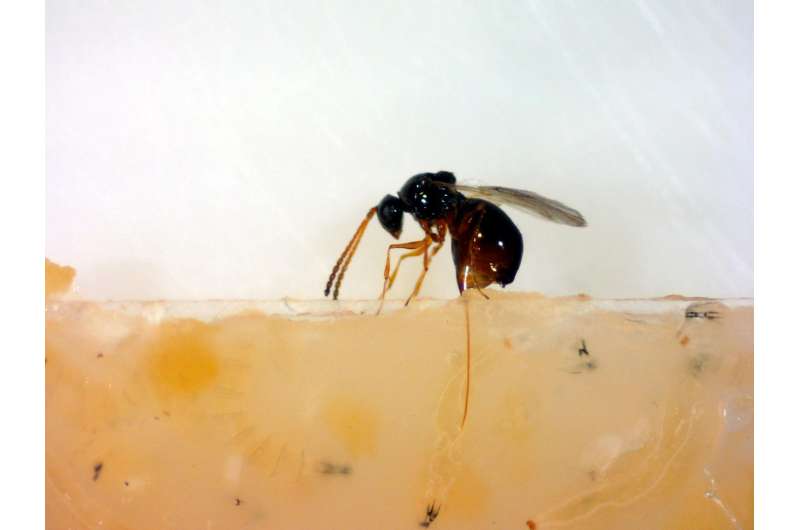Defensive bacterial symbionts of fruit flies attack ribosomes of parasitic wasps

Bacteria of the Spiroplasma genus produce toxic, ribosome-inactivating proteins (RIPs) that appear to protect their symbiotic host flies against parasitic wasps, according to new research published in PLOS Pathogens.
Spiroplasma bacteria were already known to protect some Drosophila flies against parasitic roundworms and wasps that lay their eggs inside the flies. In fact, they are just one example of many microbial symbionts that defend their hosts against enemies. However, the mechanisms of such defense are poorly understood.
In an earlier study, Finn Hamilton and Steve Perlman of the University of Victoria, Canada, and colleagues showed that the Spiroplasma strain found in Drosophila neotestacea protects the fly against roundworms and produces an RIP that attacks and disables the parasite's ribosomes. In the new study, Perlman and Matt Ballinger, also of the University of Victoria, investigated whether Spiroplasma RIPs also attack wasps.
Ballinger and Perlman exposed D. neotestacea and D. melanogaster (the common fruit fly) to three parasitic wasps. Some of the flies were infected with species-specific strains of Spiroplasma, and some were not. In Spiroplasma-infected flies, molecular analysis of the wasps' ribosomes revealed key signs of RIP attack. The encounter with Spiroplasma was deadly in two of the three wasp species; the third, a parasitic wasp that develops outside of the host's body, was not significantly affected.
Further testing showed that Spiroplasma RIPs attack wasp ribosomes immediately after the wasps hatch from eggs laid inside an infected fly. The researchers also showed that flies suffer very little collateral damage to their own ribosomes from Spiroplasma RIPs.
The genome of the Spiroplasma strain that infects D. melanogaster contains genes for five different types of RIP. In the new study, Ballinger and Perlman found that the genome of the strain that infects D. neotestacea possesses similar RIPs, as well as two RIP genes that are not shared with the D. melanogaster strain. "The symbiont has figured out how to target two dissimilar parasites without harming its host," says Ballinger. "We want to know how it does this, and we think an important clue is that Spiroplasma strains are collecting lots of different toxin genes in their tiny genomes." This diversity could explain why Spiroplasma protects against roundworms in D. neotestacea but not in D. melanogaster.
Further research could explore the role of toxins in other protective symbiotic relationships and investigate how toxin diversity may contribute to the evolution of symbiont defense against specific parasites.
More information: Ballinger MJ, Perlman SJ (2017) Generality of toxins in defensive symbiosis: Ribosome-inactivating proteins and defense against parasitic wasps in Drosophila. PLoS Pathog 13(7): e1006431. doi.org/10.1371/journal.ppat.1006431
Journal information: PLoS Pathogens
Provided by Public Library of Science


















